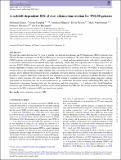A redshift-dependent IRX–β dust attenuation relation for TNG50 galaxies
Author(s)
Schulz, Sebastian; Popping, Gergö; Pillepich, Annalisa; Nelson, Dylan; Vogelsberger, Mark; Marinacci, Federico; Hernquist, Lars; ... Show more Show less
DownloadPublished version (33.90Mb)
Publisher with Creative Commons License
Publisher with Creative Commons License
Creative Commons Attribution
Terms of use
Metadata
Show full item recordAbstract
© 2020 The Author(s). We study the relation between the UV slope, β, and the ratio between the infrared-and UV luminosities (IRX) of galaxies from TNG50, the latest installment of the IllustrisTNG galaxy formation simulations. We select 7280 star-forming main-sequence (SFMS) galaxies with stellar mass ≥109 M⊙ at redshifts 0 ≤ z ≤ 4 and perform radiative transfer with skirt to model effects of interstellar medium dust on the emitted stellar light. Assuming a Milky Way dust type and a dust-to-metal ratio of 0.3, we find that TNG50 SFMS galaxies generally agree with observationally derived IRX-β relations at z ≳ 1. However, we find a redshift-dependent systematic offset with respect to empirically derived local relations, with the TNG50 IRX-β relation shifting towards lower β and steepening at higher redshifts. This is partially driven by variations in the dust-uncorrected UV slope of galaxies, due to different star formation histories of galaxies selected at different cosmic epochs; we suggest the remainder of the effect is caused by differences in the effective dust attenuation curves of galaxies as a function of redshift. We find a typical galaxy-to-galaxy variation of 0.3 dex in infrared excess (IRX) at fixed β, correlated with intrinsic galaxy properties: galaxies with higher star formation rates, star formation efficiencies, gas metallicities and stellar masses exhibit larger IRX values. We demonstrate a degeneracy between stellar age, dust geometry, and dust composition: z = 4 galaxies with a Small Magellanic Cloud dust type follow the same IRX-β relation as low-redshift galaxies with MW dust. We provide a redshift-dependent fitting function for the IRX-β relation for MW dust based on our models.
Date issued
2020Department
MIT Kavli Institute for Astrophysics and Space ResearchJournal
Monthly Notices of the Royal Astronomical Society
Publisher
Oxford University Press (OUP)
Citation
Schulz, Sebastian, Popping, Gergö, Pillepich, Annalisa, Nelson, Dylan, Vogelsberger, Mark et al. 2020. "A redshift-dependent IRX–β dust attenuation relation for TNG50 galaxies." Monthly Notices of the Royal Astronomical Society, 497 (4).
Version: Final published version